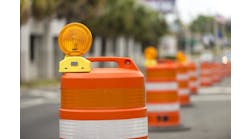ODOT work crews plow along the U.S. 33 Smart Mobility Corridor from Dublin to East Liberty in Ohio. The crews will place fiber-optic cable within these trenches to provide data links for collecting information and providing for connected/automated vehicle travel. Photo by Julia Poling, Ohio Department of Transportation, District 6 Office.
Try this for a definition of the future: When progress exceeds public expectations faster than people can raise them. It seems digital communication and information technologies are only getting started in changing the way people live their lives. This is nowhere more apparent than in transportation. With tech and automotive giants like Google and Ford already investing heavily in the integration and interface of vehicles with surrounding technology, agencies like the Ohio Department of Transportation (ODOT) are joining the effort. In the 21st century, ODOT is helping to reimagine mobility in new ways. To do so, the department must learn to work with some new concepts.
Welcome to the connected world
The model of the future is the “connected city,” a modern metropolis running with the aid of interconnected information and data exchange systems. Connected vehicles—cars and other vehicles with the ability to wirelessly communicate with other devices—are an integral part of these new cities. Indeed, connected vehicles already exist, with drivers enjoying the ability to link remotely to needed services or to their homes and offices.
Now, the automated vehicle is on the horizon: A car or truck that can be directed by advanced computers to navigate the highways without human control. When these self-driving vehicles are connected, they can arrange themselves in groups to travel at high speeds with utmost safety; they can read and adjust to signs, signals and weather conditions automatically, and avoid accidents by “seeing” hazards as well as other vehicles, whether they are milliseconds or half-a-mile or more away. The link tying connected vehicles to connected cities is the physical infrastructure, including the once humble highway.
This is where ODOT comes in, doing the research and development that will outfit existing roadways and related structures with the needed technology to allow connected and self-driving cars to communicate. The journey to make that happen has already begun.
An Otto truck, outfitted with an autonomous driving system, is live-tested near Columbus. Photo by Julia Poling, Ohio Department of Transportation, District 6 Office.
On your mark
Many state agencies across the country are not prioritizing the integration of the new advances in technology, but this is not so at ODOT. In an address made to the rotary club in Lima, Ohio, ODOT District Deputy Director Kirk Slusher stated the evolution in transportation is inevitable. “What’s happening now is the auto industry is designing these vehicles and their software of how they interpret things to [work with] the existing roadway infrastructure,” Slusher said. “You’ll see cities dive into this before rural areas, looking at their transportation fleets, looking at public transportation.”
The Ohio State University has formed a Smart Mobility Initiative, in partnership with ODOT, the Ohio Department of Public Safety and the Ohio Turnpike and Infrastructure Commission, to research the creation of this new, connected infrastructure. Other partners include the Transportation Research Center and private partners such as Nationwide Insurance, Honda and Ohio AAA.
The department has established the first Smart Mobility Corridor, a 35-mile stretch of U.S. Rte. 33 in central Ohio, and has committed $15 million to install high-capacity fiber-optic cable along this segment. The state’s investment complements another U.S. DOT grant of $6 million awarded to Dublin, Marysville and Union County, and matched by local funds, to expand their fiber-optic networks linking to U.S. 33.
The fiber-optic installation will establish an instantaneous data link with Road Side Units (RSUs), together with embedded, wireless sensors, to ODOT’s Traffic Management Center. ODOT will retrofit some of its vehicles with special sensors for detecting road conditions, such as the presence of black ice or potholes, which can be transmitted to the traffic management center instantaneously. With its own fiber-optic lines already in place, the Ohio Turnpike also is being used as a test track.
The links these roadways provide will help self-driving vehicle development. Premier automotive testing, research and manufacturing facilities will have the ability to test their smart transportation technologies on highways that carry up to 50,000 vehicles per day through rural and urban settings in a full range of weather conditions. As autonomous and connected vehicle research expands throughout the state, Ohio is set to become the centerpiece of a contiguous, interstate highway test corridor stretching through a group of states from New York to Detroit and Chicago.
“The data collected will allow automotive innovators to test and refine job-creating technologies that are going to help move people and products more safely and efficiently than ever before,” said ODOT Director Jerry Wray. “By being one of the first—and best positioned—states to embrace autonomous and connected vehicle technology, Ohio can also be among the first to benefit from its rewards.”
Facing challenges and obstacles
With so many working to create the structure for future cities and cars, ODOT officials face an inherent challenge: What does a connected city look like? And what does a connected highway need to have to serve that city?
“We are still defining those kinds of issues ourselves,” observed Andrew Bremer, ODOT’s deputy director of Strategic Initiatives & Programs. “With connected cities comes the issue of home rule; that is, each municipality having the authority to design how its connected systems will look and operate. Each city can vary widely in its set-ups; ODOT will have to find ways to adapt roadways to fit the needs of these different locations.”
ODOT’s research includes an investment with the city of Columbus as a hub for intelligent transportation. Ohio’s capital city made headlines last year when it won a $40 million Smart City grant from the U.S. DOT. As the connected cities’ model takes shape, ODOT and Columbus officials can better learn how highways and cities can tie together and address emerging issues.
The ultimate game-changer: safety
For ODOT and the public at large, safety goes to the heart of the connected cities/roadways issue. With a major push toward creating self-driving vehicles, the public will face a reality where they are either passengers in autonomous vehicles or sharing the roadways with them. A recent AAA poll revealed that 78% of those asked were afraid to ride in fully automated vehicles, with 54% wary of sharing the roadways with such vehicles. However, ODOT is on the right path: A majority of those polled favored adding connectivity services to vehicles still under human control to make them safer.
Studies by the National Highway Traffic Safety Administration show that 94% of all crashes on the nation’s highways are caused by human error. More automated vehicles would mean a dramatic reduction in accidents and fatalities. Make no mistake: The self-driving car may seem like a scary proposition, but it also could be one of the greatest safety advances in the history of automotive travel.
“ODOT knows that our preparation will not just be about the highways, but about the drivers,” said Wray. “We have to look at how to prepare the public, convincing them that it is even OK for them to let go of control, if it comes to that.”
ODOT crews place fiber-optic cable along the U.S. 33 Smart Mobility Corridor. The connectivity provided will help enable later testing of connected/automated vehicles.
Paying for it all
In this new venture, the inevitable issues arise about how to maintain financial support. ODOT believes that one answer is to form public-private partnerships. One great example has been set locally: In the year since winning $40 million dollars in federal grants from the U.S. DOT Smart Cities Challenge and an additional sum of $10 million from Vulcan Inc., the city of Columbus has raised more than $500 million in investments from private- and public-sector partnerships. Smart Columbus is well on its way to becoming a connected city.
Columbus officials said they have been consulting with every automotive manufacturing company on what they are doing in transportation and what those companies can bring to Columbus. Ohio is within 600 miles of 60% of the U.S. and Canadian populations. With its location and its wide-ranging weather conditions, the state is in a prime position to attract investments.
What the future holds
ODOT will be creating other smart corridors, such as I-90 in Lake County and I-270 in Franklin County. In late 2018, the state will roll out the I-670 Smart Lanes, which will open a shoulder as an extra lane of eastbound traffic in Columbus. The shoulder will only be opened at specific times to accommodate heavy traffic flows. Electronic signs already in place will alert drivers to which lanes are opened and what speeds they are allowed to travel at that time for safety. New strategies such as Smart Lanes combined with connected cities and vehicles represent a shift in transportation management: the use of technology to get more from existing assets.
As these pilot programs grow, the information and data generated will be shared with other agencies. ODOT Press Secretary Matt Bruning said the state is willing to work with anyone: “That’s really our goal, to make Ohio the epicenter of this industry, and we think we’re well on the way to doing that.”
----------
About the author: Poole is a public information specialist with the Ohio Department of Transportation.



